 Hans Ulrich Reck — The Myth of Media Art
Hans Ulrich Reck — The Myth of Media Art
VDG, Weimar, 2007 ISBN: 9783897395312
Unravelling what lies behind the term “media art” takes the reader of this most insightful book on a process of discovery into the world of contemporary art practice, social function, and economic position. In presenting a critique of mythologies behind the term “media art”, in this book, Hans Ulrich Reck provides a series of sketches across a range of critical inter-relationships between media, and art-as-practice, and art-as-economy. These are underpinned by a theoretically informed logic and rhetoric which is passionately and intelligently written.
As an alternative term for more effectively and precisely describing the relationship which he sketches between art and media, Hans Ulrich Reck suggests that we consider art through media. This alternative term, he convincingly suggests, is a far more precise and eloquent way to explain and understand the complexities of art and media practices in a contemporary technological 21st century. This alternative term is presented as more useful and productive, suggesting a precise understanding of the complex inter-relationships between art and media. These are described as being transformative inter-relational actions, where media/technology is positioned within, and around, creative practices, as process, tool, action, and/or events. He writes:
“Art through the media is a rhetorically differentiated mediosphere. It integrates all possible material states, from archaic to futuristic technologies. This means that the new media determinations enable an insightful glimpse into the existential conditions of art. “(p.25)
To support his perspective on the benefits of seeing art-through-media, Hans Ulrich Reck provides an insightful critique of a range of art historical contexts which contribute to this re-reading of art practice and social function through the media. As an art theory perspective, it entails a re-consideration of the ways in which art operates in the contemporary world, as an inevitable engagement with media in some capacity, which is often multi-layered and multi-faceted. This theoretical critique of art as practice through media, positions the notion of the artist as a media-maker, engaged with transformative processes which evolve through poetic mediative actions, relationships and processes.
Hans Ulrich Reck comments on the nature of contemporary art practice as a kind of mould which deploys different “cartographies,” transforming the potential relationships between virtual and real spaces. He comments that in practice, art as agency informs, and is informed by, the disintegration/restructuring of society and social forms and imaginings through what we know as the public sphere. In making these relationships more apparent, Hans Ulrich Reck calls for recognition of the importance of artistic practice, working through media, to inform and actively engage with the workings of the public sphere.
In this way, art practice, understood to be working through media, has the potential to influence and inform critical debates in the public domain. He comments:
“Today the public sphere is no longer dependent on the claim to and the presentation of an existing space, but on the formation and the influence, at best even transformation of mediatised public communication processes. The connections of locality and dislocality, of political movements and transformations taking place in the digital sphere, are both an attempt at deepening the experiences of cooperating with machines and, at the same time, restructuring an already media-shaped public sphere. “(p.159)
Hans Ulrich Reck’s critique of the “myth of media art” is effectively contained within the first section of this book, so-titled “Myth of Media Art.” It is presented to the reader as a series of linked ideas which explore and question our understandings of the very role and direction of art as media practice, grounded both in and through complex relationships and positionings. Written as a series of essays, each chapter in this first section reflects a central theme around the notion of art and media, shifting back and forward in a generative play of ideas and insights about practice, technology, culture, positionality, and poetics. The strength of the arguments presented in this often dense material are based on a deep theoretical and scholarship, yet are presented here as readable, accessible and thought provoking for a general audience.
In the second section, which is titled “Media Contexts; Key Topics, Arguments, Examples,” Hans Ulrich Reck provides a series of highly evocative and lucid essays which work to emphasise his arguments about art and its potential relationships through media. These include reflections about the development of new media spaces for practice, as insights into the dynamics of fragmentation and totalities, as some of the ways in which our understandings of media can be framed through reading social and cultural forces. The field of design is also included here, with some compelling insights into recent trends and directions in the design of media software technologies. This section finishes with some excellent readings of selected electronic arts practices, where individual practice is mapped and described through a rich and deep vein of media process, interaction and transformative actions.
The essay structure of the entire book provides readers with the opportunity to dive in to deep territory of media and art theory, and to exit and then re-enter again and again into the two hundred and thirteen pages of this English edition. The writing style, which has been translated from the original German text, is beautifully rich and evocative. For media artists, designers, practitioners, and those just keenly interested in better understanding the relationships between creative practice and media history and theory, this is an excellent book. It succinctly highlights the need for our understanding of art and media as complex and dynamic interactive creative and strategic transformative practices-in-the-world.
Associate Professor Kaye Shumack teaches at the University of Western Sydney in design theory, research and practice

